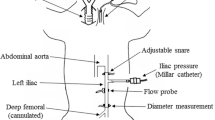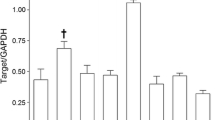Summary
Nicorandil has a hybrid property between nitrates and potassium (K)-channel openers. In order to clarify which mechanism of action is responsible for its effect in increasing coronary blood flow, we investigated how this effect was antagonized by glibenclamide, which was recently found to behave as a pharmacologic antagonist of K-channel openers. Cromakalim, one of the most specific K-channel openers currently available, and nitroglycerin were used as reference drugs. In isolated, blood-perfused papillary muscle preparations of dogs, intraarterial injections of nicorandil and cromakalim increased (coronary) blood flow, and at high doses a negative inotropic effect and ventricular fibrillation occurred. Dose-response curves for the increase in coronary blood flow produced by nicorandil or cromakalim were shifted to the right in a parallel manner and to similar extents by glibenclamide given intravenously to support dogs. Schild analysis yielded pA2 values of 6.08 and 6.34 for glibenclamide versus nicorandil and cromakalim, respectively. Nitroglycerin injected intraarterially produced only an increase in coronary blood flow. This effect was not affected by glibenclamide. These results indicate that the effect of nicorandil in increasing coronary blood flow, like that of cromakalim, is predominantly due to its mechanism of action as a K-channel opener. The negative inotropy and ventricular fibrillation seen with high doses of nicroandil and cromakalim were also antagonized by glibenclamide, indicating that these effects are also due to K-channel opening.
Similar content being viewed by others
References
Taira N. Similarity and dissimilarity in the mode and mechanism of action between nicorandil and classical nitrates: An overview.J Cardiovasc Pharmacol 1987;10(Suppl 8):S1–S9.
Taira N. Nicorandil as a hybrid between nitrates and potassium channel activators.Am J Cardiol 1989;63:18J-24J.
Taira N, Satoh K, Yanagisawa T, et al. Pharmacological profile of a new coronary vasodilator drug, 2-nicotinamidoethyl nitrate (SG-75).Clin Exp Pharmacol Physiol 1979;6:301–316.
Yanagisawa T, Taira N. Effect of 2-nicotinamidethyl nitrate (SG-75) on the membrane potential of left atrial muscle fibres of the dog. Increase in potassium conductance.Naunyn Schmiedebergs Arch Pharmacol 1980;312:69–76.
Yanagisawa T, Taira N. Effect of 2-nicotinamidethyl nitrate (SG-75) on membrane potentials of canine Purkinje fibers.Jpn J Pharmacol 1981;31:409–417.
Yanagisawa T, Satoh K, Taira N. Circumstantial evidence for increased potassium conductance of membrane of cardiac muscle by 2-nicotinamidoethyl nitrate (SG-75).Jpn J Pharmacol 1979;29:687–694.
Yanagisawa T, Hashimoto H, Taira N. The negative inotropic effect of nicorandil is independent of cyclic GMP changes: A comparison with pinacidil and cromakalim in canine atrial muscle.Br J Pharmacol 1988;95:393–398.
Yanagisawa T, Hashimoto H, Taira N. Interaction of potassium channel openers and blockers in canine atrial muscle.Br J Pharmacol 1989;97:753–762.
Weir SW, Weston AH. The effects of BRL 34915 and nicorandil on electrical and mechanical activity and on86Rb efflux in rat blood vessels.Br J Pharmacol 1986;88:121–128.
Coldwell MC, Howlett DR. Specificity of action of the novel antihypertensive agent, BRL 34915, as a potassium channel activator. Comparison with nicorandil.Biochem Pharmacol 1987;36:3663–3669.
Schmid-Antomarchi H, De Weille J, Fosset M, Lazdunsky M. The receptor for antidiabetic sulfonylureas controls the activity of the ATP-modulated K+ channel in insulinsecreting cells.J Biol Chem 1987;262:15840–15844.
Cavero I, Mondot S, Mestre M, Escande D. Hemodynamic and pharmacological mechanisms of the hypotensive effects of cromakalim in rats: Blockade by glibenclamide.Br J Pharmacol 1988;95:643P.
Cavero I, Mondot S, Mestre M. Vasorelaxant effects of cromakalim in rats are mediated by glibenclamide-sensitive potassium channels.J Pharmacol Exp Ther 1989;248:1261–1268.
Etlze M. Glibenclamide is a competitive antagonist of cromakalim, pinacidil and RP 49356 in guinea-pig pulmonary artery.Eur J Pharmacol 1989;165:231–239.
Endoh M, Hashimoto K. Pharmacological evidence of autonomic nerve activities in canine papillary muscle.Am J Physiol 1970;218:1459–1463.
Arunlakshana O, Schild HO. Some quantitative uses of drug antagonists.Br J Pharmacol 1959;14:48–58.
Gotanda K, Satoh K, Taira N. Is the cardiovascular profile of BRL 34915 characteristic of potassium channel activators?J Cardiovasc Pharmacol 1988;12:239–246.
Endoh M, Taira N. Relationship between relaxation and cyclic GMP formation caused by nicorandil in canine mesenteric artery.Naunyn Schmiedebergs Arch Pharmacol 1983;322:319–321.
Holzmann S. Cyclic GMP as possible mediator of coronary arterial relaxation by nicorandil (SG-75).J Cardiovasc Pharmacol 1983;5:364–370.
Fam WM, McGregor M. Effect of nitroglycerin and dipyridamole on regional coronary resistance.Circ Res 1968; 22:649–659.
Winbury MM, Howe BB, Hefner MA. Effect of nitrates and other coronary dilators on large and small coronary vessels: An hypothesis for the mechanism of action of nitrates.J Pharmacol Exp Ther 1969;168:70–95.
Zünkler BJ, Lenzen S, Manner K, et al. Concentrationdependent effects of tolbutamide, meglitinide, glipizide, glibenclamide and diazoxide on ATP-regulated K+ currents in pancreatic B-cells.Naunyn Schmiedebergs Arch Pharmacol 1988;337:225–230.
Standen NB, Quayle SJ, Davies NW, et al. Hyperpolarizing vasodilators activate ATP-sensitive K+ channels in arterial smooth muscle.Science 1989;245:177–180.
Fosset M, De Weille JR, Green RD, et al. Antidiabetic sulfonylureas control action potential properties in heart cells via high affinity receptors that are linked to ATP-dependent K+ channels.J Biol Chem 1988;263:7933–7936.
Endoh M, Yanagisawa T, Taira N. Effects of 2-nicotinamidoethyl nitrate (SG-75), a new antianginal drug, on cyclic AMP phosphodiesterase activity.Tohoku J Exp Med 1980; 130:199–201.
Endoh M, Iijima T. Effects of nicorandil and its interaction with isoproterenol on force of contraction and cyclic nucleotide levels of canine atrial muscle: Comparison with carbachol.J Cardiovasc Pharmacol 1983;5:878–882.
Author information
Authors and Affiliations
Rights and permissions
About this article
Cite this article
Yoneyama, F., Satoh, K. & Taira, N. Nicorandil increases coronary blood flow predominantly by K-channel opening mechanism. Cardiovasc Drug Ther 4, 1119–1126 (1990). https://doi.org/10.1007/BF01856508
Issue Date:
DOI: https://doi.org/10.1007/BF01856508




